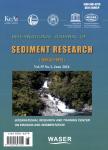Characteristics of runoff and sediment yield for two typical erodible soils in southern China
Characteristics of runoff and sediment yield for two typical erodible soils in southern China作者机构:State Key Laboratory of Soil and Sustainable Agriculture Institute of Soil Science Chinese Academy of Sciences College of Advanced Agricultural Sciences University of Chinese Academy of Sciences College of Ecology and Environment Chengdu University of Technology National-Regional Joint Engineering Research Center for Soil Pollution Control and Remediation in South China Guangdong Key Laboratory of IntegratedAgro-environmental Pollution Control and Management Institute of Eco-environmental and Soil Sciences Guangdong Academy of Sciences Hydrology and Water Resources Investigation Bureau of Jiangsu Province
出 版 物:《International Journal of Sediment Research》 (国际泥沙研究(英文版))
年 卷 期:2022年第37卷第5期
页 面:653-661页
核心收录:
学科分类:082802[工学-农业水土工程] 090707[农学-水土保持与荒漠化防治] 0907[农学-林学] 08[工学] 0828[工学-农业工程] 09[农学] 0815[工学-水利工程]
基 金:financially supported by the National Key Research and Development Program of China (Grant Nos. 2018YFC1801801 and 2019YFC1805104) the Soil and Water Conservation Monitoring Station of Jiangsu Province (Grant No. JSSW201911005) the Water Conservancy Science and Technology Projects of Jiangsu Province (Grant Nos. 2020051 and 2021059) the National Natural Science Foundation of China (Grant Nos. 41807019 and 42177305) the Natural Science Foundation of Jiangsu Province, China (Grant No. BK20181109)
主 题:Runoff and sediment characteristics Sediment-yield simulation Granite red soil Quaternary red clay Pedotransfer function Red-soil region
摘 要:Granite red soil(GRS) and Quaternary red clay(QRC) are two typical erodible soils in the red-soil region of southern China. Analytical and comparative studies of the characteristics of runoff and sediment yield for the two soils at various slopes are currently needed. The purpose of the current study was to clarify the characteristics of runoff and sediment yield for GRS and QRC at different slopes and to establish models for estimating sediment yield for the two soils. Forty-eight runoff microplots with four slopes(5°, 15°, 25°, and 35°) and two soils(GRS and QRC) were established and exposed to natural rainfall. Runoff and sediment yield were measured 10 times during the study period. Runoff and sediment yield for the two soils under the various slopes had similar temporal variations, and both increased with prior cumulative erosive rainfall. Runoff for GRS and QRC was moderately temporally variable, with coefficients of variation(CVs) from 46.2% to 60.6%, and sediment yield for QRC was strongly temporally variable, with CVs from 114.8% to 145.8%. Sediment yield for GRS increased with slope, but sediment yield for QRC first increased and then decreased, with a calculated inflection point of 18°, but runoff for both soils decreased with slope. The CVs of both runoff and sediment yield with slope for the two soils ranged from 3.6% to 88.0%, lower than the temporal variabilities, indicating that rainfall may have a larger impact than slope on runoff and sediment yield for QRC and GRS. Under the various slopes, runoff and sediment yield for both soils increased with rainfall and sediment yield increased with runoff, but the proportions of effective rainfall and runoff differed. Pedotransfer-function models based on rainfall, runoff, and slope accurately estimated sediment yield for the two soils, with the model fit coefficient of determination(R2) 0.81 and the R2for verification 0.79. These results improve the understanding of the laws governing erosion for differe



